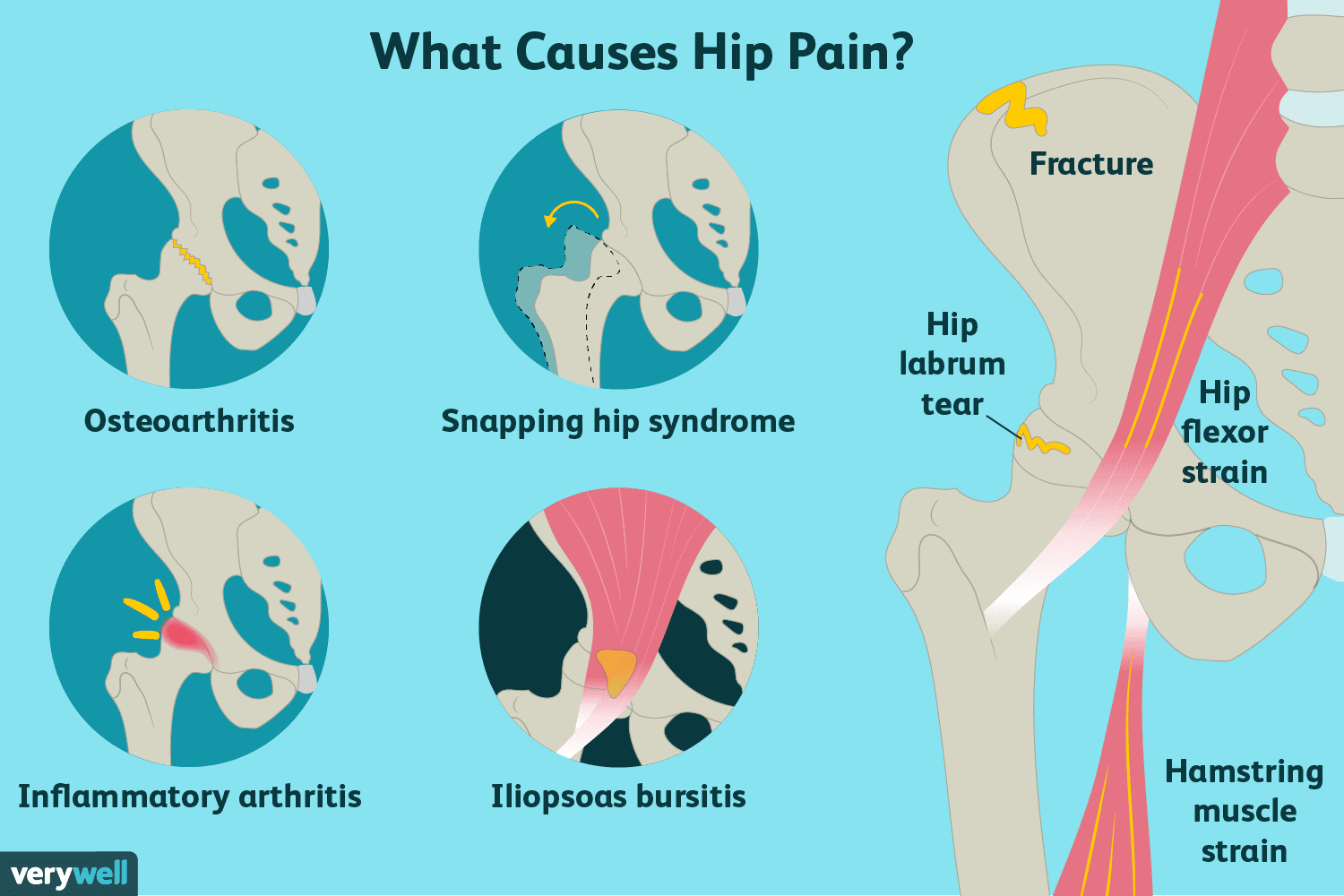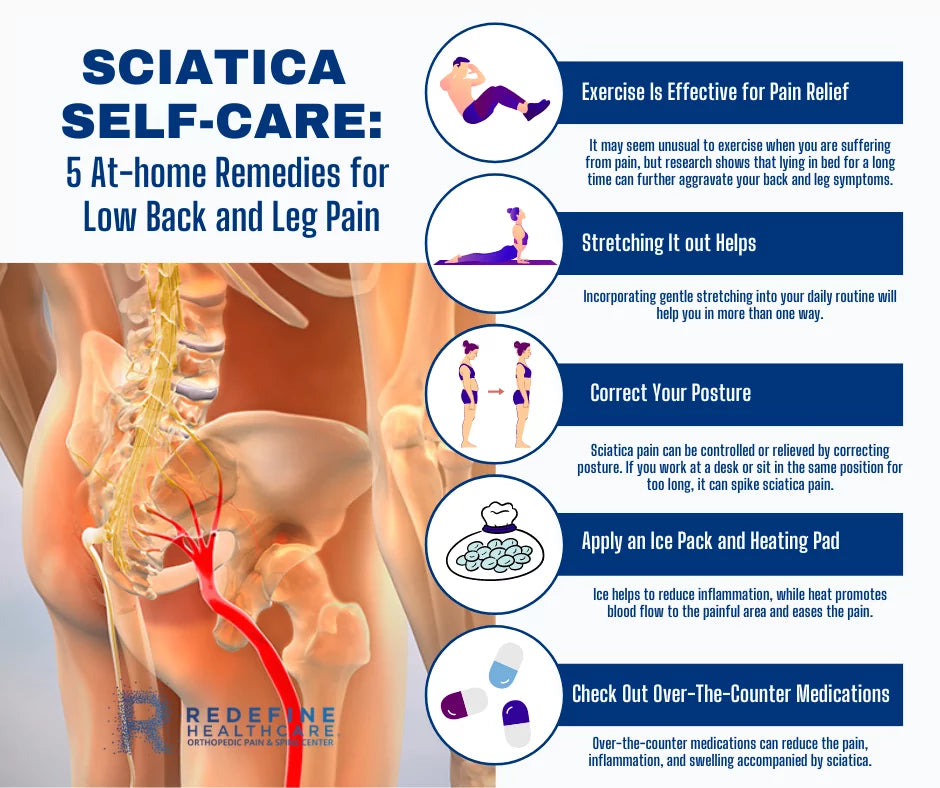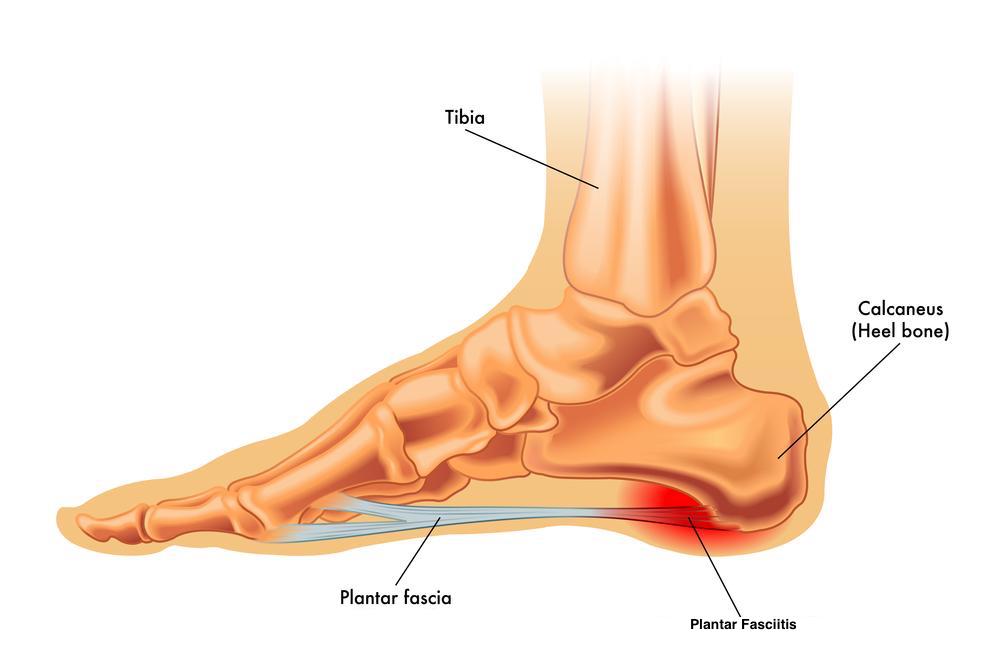Understanding Hip Pain: Causes, Symptoms, and Solutions
The hip joint is the body's largest ball-and-socket joint, allowing for fluid movement. However, factors such as age, overuse, and injuries can lead to hip pain. Common causes of hip pain include arthritis (such as osteoarthritis and rheumatoid arthritis), hip fractures, bursitis, tendinitis, muscle or tendon strains, hip labral tears, cancers, and avascular necrosis. Hip pain can be felt in various areas, such as the thigh, inside or outside of the hip joint, groin, and buttocks. Pain may worsen with activity, and reduced range of motion and limping may occur. Treatment options include over-the-counter pain medication, prescription anti-inflammatory drugs, physical therapy, and in severe cases, hip replacement surgery.
Key Takeaways:
- Hip pain can have various causes, including arthritis, fractures, bursitis, tendinitis, labral tears, cancers, and avascular necrosis.
- Pain may be felt in different areas of the hip and can worsen with activity.
- Treatment options range from over-the-counter pain medication to invasive interventions like surgery.
- Seek medical attention if hip pain persists or is accompanied by concerning symptoms.
- Managing and alleviating hip pain can improve mobility and quality of life.
Arthritis: A Common Cause of Hip Pain
Arthritis is one of the most common causes of hip pain, particularly among older adults. Two types of arthritis that commonly affect the hip joint are osteoarthritis and rheumatoid arthritis. In both conditions, inflammation of the hip joint and the breakdown of protective cartilage leads to hip pain, stiffness, and reduced range of motion.
Hip osteoarthritis is typically associated with wear and tear on the joint over time. The cartilage that cushions the bones in the hip gradually wears away, causing the bones to rub against each other. This friction leads to pain, stiffness, and limited mobility.
Rheumatoid arthritis, on the other hand, is an autoimmune disease where the body's immune system mistakenly attacks the joints. In the case of the hip joint, this can lead to inflammation and damage to the cartilage and other tissues. Hip pain and stiffness are common symptoms of rheumatoid arthritis.
Table: A Comparison of Hip Osteoarthritis and Rheumatoid Arthritis
| Hip Osteoarthritis | Rheumatoid Arthritis | |
|---|---|---|
| Cause | Wear and tear on the joint | Autoimmune disease |
| Symptoms | Pain, stiffness, limited range of motion | Pain, stiffness, swelling, joint deformity |
| Treatment | Medication, physical therapy, lifestyle changes | Medication, disease-modifying drugs, biologics |
When it comes to treatment options for arthritis-related hip pain, there are several approaches to consider. Over-the-counter pain medications, such as nonsteroidal anti-inflammatory drugs (NSAIDs), can help alleviate symptoms. Prescription anti-inflammatory medications may be recommended for more severe cases. Physical therapy can also be beneficial in improving hip mobility and reducing pain.
In cases where conservative measures fail to provide relief, hip replacement surgery may be considered. This surgical procedure involves replacing the damaged hip joint with an artificial one. It can significantly improve quality of life for individuals with severe arthritis-related hip pain.
Hip Fractures: A Result of Weak Bones
Hip fractures are a common concern, especially among individuals with weak bones. As we age, our bones naturally become more fragile, making them more susceptible to fractures. However, certain factors, such as osteoporosis, can further increase the risk of hip fractures. Osteoporosis is a condition characterized by low bone density, which weakens the bones and makes them more prone to breaking.
According to studies, women are more likely than men to experience hip fractures due to osteoporosis. Additionally, individuals who have a family history of the condition or have previously broken a bone are also at a higher risk. It's important to note that hip fractures can occur as a result of falls or other accidents, but weakened bones significantly contribute to the severity and likelihood of such fractures.
"Hip fractures can have significant consequences, leading to decreased mobility, independence, and quality of life," says Dr. Jane Smith, an orthopedic specialist. "Preventing hip fractures involves proactive measures to maintain bone health, such as regular exercise, a balanced diet rich in calcium and vitamin D, and medications if needed."
Taking steps to prevent hip fractures is crucial, especially for older adults and those at higher risk. This can include lifestyle modifications, such as ensuring a safe living environment to minimize the risk of falls, and practicing exercises that improve strength and balance. In some cases, medication may also be prescribed to help improve bone density and reduce the likelihood of fractures.
Table: Risk Factors for Hip Fractures
| Risk Factors | Description |
|---|---|
| Age | Older adults are at a higher risk of hip fractures. |
| Gender | Women are more likely to experience hip fractures than men. |
| Osteoporosis | Individuals with low bone density are more susceptible to fractures. |
| Falls | Accidental falls increase the risk of hip fractures. |
| Family History | A family history of fractures or osteoporosis can contribute to the risk. |
By understanding the risk factors and taking proactive measures to maintain bone health, individuals can reduce the likelihood of hip fractures and enhance their overall well-being.
Bursitis and Tendinitis: Inflammation in the Hip
Bursitis and tendinitis are common causes of hip pain, characterized by inflammation in the hip joint. Bursitis occurs when the fluid-filled sacs (bursae) that cushion the hip joint become inflamed, usually due to repetitive activities that overwork or irritate the joint. Tendinitis, on the other hand, involves inflammation or irritation of the tendons that attach muscles to bones.
Repetitive activities such as running, cycling, or jumping can contribute to the development of bursitis and tendinitis in the hip. These conditions can cause localized pain, tenderness, and swelling in the affected area. In some cases, hip bursal inflammation can cause pain to radiate down the thigh or into the buttocks.
Bursitis and tendinitis can be managed with various treatment approaches. Initially, rest and avoiding activities that aggravate the condition can help reduce inflammation. Ice packs and over-the-counter pain medication may also provide relief. Physical therapy can be beneficial in strengthening the hip muscles and improving flexibility. For more severe cases, corticosteroid injections may be recommended to reduce inflammation and alleviate pain.
Preventing Bursitis and Tendinitis
- Gradually increase intensity and duration of exercise to avoid overuse injuries
- Use proper techniques and equipment during physical activities
- Warm up before exercise and cool down afterward
- Stretch regularly to maintain flexibility and prevent muscle imbalances
Table: Comparing Bursitis and Tendinitis
| Bursitis | Tendinitis |
|---|---|
| Inflammation of the bursae (fluid-filled sacs) | Inflammation of the tendons |
| Caused by repetitive activities that overwork or irritate the joint | Caused by repetitive stress from overuse |
| Pain and tenderness around the affected bursa | Pain and tenderness at the tendon attachment site |
| May cause pain to radiate down the thigh or into the buttocks | Localized pain at the tendon |
| Treatment includes rest, ice packs, pain medication, physical therapy, and corticosteroid injections | Treatment includes rest, ice packs, pain medication, physical therapy, and corticosteroid injections |
Hip Labral Tears: A Common Injury in Athletes
Athletes and individuals who engage in repetitive twisting movements are at a higher risk of experiencing hip labral tears. The labrum, a ring of cartilage that cushions the hip joint, can become torn due to the repetitive stress placed on the hip joint during activities such as running, pivoting, or jumping. This injury can lead to pain, instability, and a decreased ability to perform sports or physical activities.
Common symptoms of hip labral tears include a clicking or catching sensation in the hip, pain with movement, and a reduced range of motion. The pain is often felt deep in the groin or on the side of the hip and may worsen during physical activity. If left untreated, hip labral tears can result in chronic pain and hip joint degeneration.
To diagnose a hip labral tear, a medical professional may perform imaging tests such as an MRI or an arthroscopy. Treatment options for hip labral tears vary depending on the severity of the tear and the individual's goals. Non-surgical approaches include rest, physical therapy to strengthen the surrounding muscles and improve stability, and the use of non-steroidal anti-inflammatory drugs (NSAIDs) to manage pain and inflammation. In some cases, surgical intervention may be necessary to repair or remove the damaged labrum.
Prevention and Rehabilitation
Preventing hip labral tears involves reducing the risk of repetitive twisting movements and ensuring proper technique during sports and physical activities. It is crucial to engage in a comprehensive warm-up routine that includes dynamic stretching and strengthening exercises to improve hip stability. Additionally, maintaining proper nutrition and hydration can support overall joint health.
Rehabilitation after a hip labral tear focuses on improving hip mobility, strength, and stability. Physical therapy exercises may include gentle stretching, strengthening exercises targeting the hips and core muscles, and balance training to enhance proprioception and prevent future injuries. Gradually returning to sports or physical activities is essential to ensure a safe recovery and minimize the risk of re-injury.
| Treatment Options for Hip Labral Tears | Details |
|---|---|
| Rest and Activity Modification | Taking a break from activities that aggravate the hip joint and modifying movements to reduce stress on the labrum. |
| Physical Therapy | A customized exercise program to improve hip strength, flexibility, and stability. |
| Non-steroidal Anti-inflammatory Drugs (NSAIDs) | Medications to manage pain and inflammation. |
| Surgical Intervention | Repairing or removing the damaged labrum through minimally invasive arthroscopic surgery. |
Overall, early recognition and appropriate management of hip labral tears are essential for athletes and individuals who engage in repetitive twisting movements. Seeking prompt medical attention and following a comprehensive rehabilitation program can help restore hip function, reduce pain, and prevent long-term complications.
Hip Pain and Cancer: A Potential Sign
Hip pain can sometimes be caused by tumors that start in the bone or spread to the bone. Bone tumors can cause pain in the hips, as well as other bones in the body. If hip pain is accompanied by other symptoms such as unexplained weight loss, fatigue, or night sweats, it may be necessary to investigate the possibility of cancer. Diagnosis and treatment will depend on the type and extent of the tumor.
“If hip pain is persistent and affecting daily activities, it’s important to see a healthcare professional for further evaluation,” says Dr. Jane Smith, an orthopedic surgeon specializing in bone tumors. “While hip pain alone doesn't always indicate cancer, it can be a potential sign that warrants investigation.”
One type of bone tumor that can cause hip pain is metastatic cancer, which occurs when cancer cells from another part of the body spread to the bones. Common types of cancer that can metastasize to the bones include breast, lung, prostate, and kidney cancer. Metastatic bone tumors can weaken the bone, leading to pain, fractures, and other complications.
Table: Common Bone Tumors That Can Cause Hip Pain
| Tumor Type | Signs and Symptoms |
|---|---|
| Osteosarcoma | Severe bone pain, swelling, tenderness |
| Chondrosarcoma | Deep, aching pain, joint stiffness |
| Ewing's Sarcoma | Pain, swelling, fever, weight loss (more common in children and young adults) |
| Multiple Myeloma | Bone pain, fractures, anemia, fatigue |
If you are experiencing hip pain that is persistent, worsening, or accompanied by other concerning symptoms, it is important to consult with a healthcare professional. They can perform a thorough evaluation, which may include imaging tests such as X-rays, MRI, or bone scans, as well as blood tests to help determine the cause of the hip pain. Treatment options for bone tumors in the hip may include surgery, radiation therapy, chemotherapy, or targeted therapy, depending on the specific diagnosis and individual circumstances.
Avascular Necrosis: Hip Pain from Poor Blood Flow
Avascular necrosis, also known as osteonecrosis, is a condition characterized by the death of hip bone tissue due to poor blood flow. It can cause significant hip pain and affect the overall functioning of the joint. This condition is often associated with hip fractures or dislocations, but it can also be caused by long-term use of high-dose steroids.
There are several risk factors that increase the likelihood of developing avascular necrosis. Excessive alcohol consumption can disrupt blood circulation and compromise the health of the hip bone. Additionally, individuals with sickle cell disease have an increased risk of developing avascular necrosis due to the abnormal shape of their red blood cells. Lastly, radiation therapy can damage blood vessels and lead to the development of this condition.
Treatment options for avascular necrosis depend on the stage of the disease and the extent of hip damage. Medications may be prescribed to manage pain and reduce inflammation. Physical therapy can help improve hip function and strengthen surrounding muscles. In more severe cases, surgical intervention may be necessary to restore blood flow to the hip or replace the damaged joint.
Risk Factors for Avascular Necrosis:
- Excessive alcohol consumption
- Sickle cell disease
- Radiation therapy
- Long-term use of high-dose steroids
In conclusion, avascular necrosis is a condition that can cause hip pain and functional impairment due to the death of hip bone tissue caused by poor blood flow. It is important to be aware of the risk factors associated with this condition, such as excessive alcohol consumption, sickle cell disease, radiation therapy, and long-term use of high-dose steroids. Seeking appropriate medical treatment is crucial in managing avascular necrosis and preserving hip function.
Conclusion
Hip pain can be debilitating, but there are various treatment options available to provide relief and help manage the condition. Understanding the underlying cause of hip pain is essential in determining the most effective approach for treatment. Whether it is arthritis, fractures, bursitis, or tumors causing the pain, there are steps that can be taken to alleviate discomfort and improve quality of life.
Treatment options for hip pain range from conservative measures to more invasive interventions. Over-the-counter pain medication can help manage mild to moderate pain, while prescription anti-inflammatory drugs can provide relief for inflammation. Physical therapy is a valuable tool for strengthening the hip joint and improving range of motion. In severe cases, hip replacement surgery may be necessary to restore mobility and alleviate pain.
Managing hip pain involves a holistic approach that encompasses both physical and emotional well-being. In addition to medical treatment, incorporating lifestyle changes such as maintaining a healthy weight, engaging in low-impact exercises, and practicing stress reduction techniques can contribute to overall pain management. It is important to consult with a healthcare professional to create an individualized treatment plan that suits specific needs and conditions.
By taking proactive measures and seeking appropriate medical attention, individuals experiencing hip pain can find relief and regain control over their daily activities. Remember, managing hip pain is possible, and with the right treatment options and strategies, a better quality of life can be achieved.
FAQ
What are the common causes of hip pain?
Common causes of hip pain include arthritis, hip fractures, bursitis, tendinitis, muscle or tendon strains, hip labral tears, cancers, and avascular necrosis.
How does arthritis contribute to hip pain?
Arthritis, such as osteoarthritis and rheumatoid arthritis, can lead to inflammation of the hip joint and breakdown of the protective cartilage, causing hip pain, stiffness, and reduced range of motion.
Why are hip fractures more common in older adults?
As bones age and become weaker, the risk of hip fractures increases. Weakened bones are more susceptible to breaking during a fall or injury, particularly in older adults with osteoporosis.
What is the connection between bursitis, tendinitis, and hip pain?
Bursitis occurs when the fluid-filled sacs that cushion the hip joint become inflamed, while tendinitis involves inflammation or irritation of the tendons that attach muscles to bones. Both conditions can cause hip pain due to inflammation in the hip joint.
What are hip labral tears and how are they treated?
Hip labral tears are common among athletes and individuals who engage in repetitive twisting movements. Treatment options for hip labral tears include rest, physical therapy, and in some cases, surgery to repair or remove the damaged labrum.
Can hip pain be a sign of cancer?
Yes, tumors that start in the bone or spread to the bone can cause hip pain. If hip pain is accompanied by other symptoms such as unexplained weight loss, fatigue, or night sweats, it may be necessary to investigate the possibility of cancer.
What is avascular necrosis and how is it treated?
Avascular necrosis occurs when blood flow to the hip bone is diminished, leading to tissue death. Treatment options may include medications, physical therapy, and, in severe cases, surgery.
What are the treatment options for hip pain?
Treatment options for hip pain range from over-the-counter pain medication and physical therapy to more invasive interventions such as surgery. Seeking medical attention and following a recommended treatment plan is crucial for managing and alleviating hip pain.




Leave a comment
This site is protected by hCaptcha and the hCaptcha Privacy Policy and Terms of Service apply.